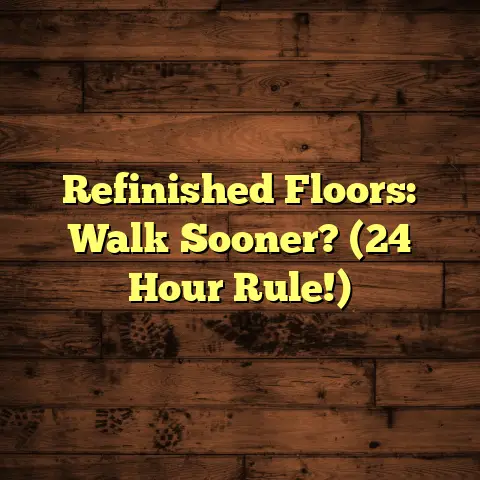Dog Afraid Of Hardwood Floors? (6 Quick Fixes!)
Have you ever watched your furry friend tiptoe around your house like they’re walking on hot coals?
It’s heartbreaking, right?
Seeing your dog terrified of hardwood floors is a common problem I see all the time.
And believe me, I get it!
You want your dog to feel safe and comfortable in their own home, not stressed out by the very floors they walk on.
That’s why I’m here to share six quick fixes that can help your dog overcome their fear of hardwood floors.
These are practical solutions I’ve used with my own clients, and I’m confident they can make a real difference for you and your pup!
Let’s start with a simple, immediate solution: using area rugs or mats.
This is often the first thing I recommend to my clients.
Think of it as creating a safe, comfortable pathway for your dog.
A few well-placed rugs can give them the confidence to navigate your home without feeling like they’re on an ice rink.
Ready to dive in?
Understanding the Fear
Okay, before we jump into the fixes, let’s talk about why your dog might be scared of hardwood floors in the first place.
It’s not just about being dramatic (though some dogs are masters of drama!).
There are actually some very real reasons behind this fear.
One of the biggest culprits?
Slippery Surfaces.
Hardwood floors can be incredibly slippery, especially for dogs with long nails or short legs.
Imagine trying to walk on ice all the time – you’d be pretty nervous, too!
Another factor can be Past Traumatic Experiences.
Maybe your dog slipped and fell on the hardwood floor once, or maybe they had a bad experience in a place with similar flooring.
Dogs have excellent memories, and those negative experiences can stick with them.
And then there’s the issue of Unfamiliarity.
If your dog has primarily lived in homes with carpet, hardwood floors can be a completely new and strange experience.
The texture, the sound of their nails clicking – it can all be quite overwhelming.
Let me tell you about a case I worked on a few years back.
A client of mine, Sarah, had a sweet little Golden Retriever named Buddy.
Buddy was absolutely terrified of the new hardwood floors she had installed.
He would cower in the corners of the rooms, refusing to move unless he was practically dragged.
After talking to Sarah, I learned that Buddy had slipped and fallen on the hardwood floor shortly after it was installed.
That single incident had created a huge fear in him.
It just goes to show how sensitive dogs can be, and how important it is to address their fears with patience and understanding.
Quick Fix #2: Gradual Exposure
Alright, now that we understand why your dog might be afraid, let’s talk about how to help them overcome that fear.
My second quick fix is all about Gradual Exposure.
Think of it as slowly introducing your dog to the hardwood floors in a positive and controlled way.
The key here is to take it slow and be patient.
Don’t force your dog to do anything they’re not comfortable with.
Here’s a step-by-step approach I recommend:
-
Step 1: Start Small.
Begin with short, positive exposure sessions.
Maybe just a few minutes at a time.
The goal is to get your dog comfortable being in the same room as the hardwood floor, even if they’re not actually walking on it.
-
Step 2: Create a Calm Environment.
Make sure the environment is calm and relaxed.
No loud noises, no sudden movements.
You want your dog to feel safe and secure.
-
Step 3: Use Treats and Praise.
This is where the fun begins!
Use high-value treats and lots of praise to reinforce positive behavior.
Every time your dog takes a step on the hardwood floor, reward them with a treat and lots of verbal encouragement.
-
Step 4: Gradually Increase Exposure.
As your dog becomes more comfortable, gradually increase the length of the exposure sessions.
You can also start encouraging them to explore more of the hardwood floor.
-
Step 5: End on a Positive Note.
Always end each session on a positive note.
Even if your dog only took a few steps, praise them and give them a treat.
You want them to associate the hardwood floor with positive experiences.
Remember, consistency is key.
Try to do these exposure sessions every day, even if it’s just for a few minutes.
With time and patience, your dog will start to feel more comfortable on the hardwood floor.
Quick Fix #3: Anti-Slip Solutions
Okay, let’s talk about something that can make a HUGE difference for dogs on hardwood floors: Anti-Slip Solutions!
This is a game-changer, trust me.
There are several different options available, and the best one for your dog will depend on their size, breed, and personal preferences.
Here are a few of my favorites:
-
Non-Slip Socks:
These are exactly what they sound like – socks with rubber grips on the bottom.
They provide excellent traction and can help prevent your dog from slipping and sliding.
Just make sure you get the right size!
Too tight, and they’ll be uncomfortable.
Too loose, and they’ll just fall off.
I recommend trying a brand like RC Pet Products.
-
Paw Wax:
Paw wax is a balm that you apply to your dog’s paw pads.
It creates a protective barrier and provides extra grip.
This is a great option for dogs who don’t like wearing socks.
Look for paw waxes that are made with natural ingredients and are safe for your dog to lick.
Musher’s Secret Paw Protection is a popular and effective choice.
-
Grip-Enhancing Sprays:
These sprays are designed to be applied directly to the hardwood floor.
They create a slightly tacky surface that provides better traction for your dog.
However, I’m often hesitant to recommend these, because they can sometimes leave a residue on the floor.
If you do decide to use a grip-enhancing spray, be sure to test it in an inconspicuous area first to make sure it doesn’t damage your floors.
Also, make sure it is safe for pets!
I recommend asking your flooring contractor about this before applying any sprays.
When choosing an anti-slip solution, consider your dog’s individual needs and preferences.
Some dogs love wearing socks, while others absolutely hate them.
Experiment with different options until you find one that works well for your pup.
And remember, even with anti-slip solutions, it’s still important to take things slow and be patient.
Quick Fix #4: Creating Safe Spaces
This next fix is all about giving your dog a sense of security and control.
I’m talking about Creating Safe Spaces.
Think of a safe space as your dog’s personal sanctuary – a place where they can retreat when they feel anxious or overwhelmed.
Having a designated safe space can make a HUGE difference in how your dog feels about your home, especially if they’re afraid of the hardwood floors.
Here are a few tips for creating the perfect safe space:
-
Choose a Quiet Location.
Select a quiet, out-of-the-way location for your dog’s safe space.
A corner of a room, a closet, or even under a table can work well.
-
Make it Cozy and Comfortable.
Fill the safe space with soft bedding, their favorite toys, and anything else that will make them feel comfortable and secure.
A familiar-smelling blanket can be especially helpful.
-
Use Gates or Barriers.
If necessary, use gates or barriers to create a defined area for the safe space.
This can help your dog feel more secure and prevent them from wandering onto the hardwood floor when they’re feeling anxious.
-
Never Force Your Dog into the Safe Space.
The safe space should always be a voluntary retreat, not a punishment.
Never force your dog to go into the safe space, as this will only make them feel more anxious.
-
Encourage Positive Associations.
Encourage your dog to spend time in their safe space by giving them treats, toys, or attention when they’re in there.
You want them to associate the safe space with positive experiences.
I often recommend my clients to use a dog crate as a safe space.
Many dogs naturally feel secure in a crate, as it provides a den-like atmosphere.
Just be sure to introduce the crate gradually and make it a positive experience for your dog.
Remember, the goal is to create a space where your dog feels safe, secure, and in control.
By providing them with a designated safe space, you can help them overcome their fear of hardwood floors and feel more comfortable in your home.
Quick Fix #5: Training Commands
Okay, let’s talk about how you can use training to help your dog navigate hardwood floors with confidence.
My fifth quick fix is all about Training Commands.
You might be surprised at how effective this can be!
By teaching your dog specific commands, you can help them feel more secure and in control when they’re walking on the hardwood floor.
Here are a few commands that I find particularly helpful:
-
“Come”:
This is a basic command that can be used in a variety of situations.
When your dog is hesitant to walk on the hardwood floor, use the “come” command to encourage them to approach you.
Reward them with praise and a treat when they do.
-
“Go”:
This command can be used to encourage your dog to move forward on the hardwood floor.
Point to a specific spot and say “go.”
When your dog reaches the spot, reward them with praise and a treat.
-
“Stay”:
This command can be used to help your dog stay in one place on the hardwood floor.
This can be helpful if you need to stop and adjust your dog’s anti-slip socks, or if you just want them to take a break.
-
“Slow”:
This command can be used to encourage your dog to walk slowly on the hardwood floor.
This can be helpful if they’re tendency to slip and slide.
When training your dog on hardwood floors, it’s important to be patient and consistent.
Start with short training sessions and gradually increase the length as your dog becomes more comfortable.
Use positive reinforcement, such as treats and praise, to reward your dog for good behavior.
And never punish your dog for being afraid or hesitant.
Remember, the goal is to help them feel more confident, not more anxious.
In addition to these specific commands, you can also use general obedience training to improve your dog’s overall confidence and obedience.
A well-trained dog is more likely to feel secure and in control, which can help them overcome their fear of hardwood floors.
Quick Fix #6: Professional Help
Okay, we’ve covered a lot of ground so far.
But sometimes, despite our best efforts, our dogs just need a little extra help.
That’s where my sixth quick fix comes in: Professional Help.
There’s absolutely no shame in seeking professional guidance from a dog trainer or behaviorist.
In fact, it can be one of the most effective ways to address your dog’s fear of hardwood floors.
A professional can assess your dog’s specific needs and develop a tailored training program that addresses their individual fears and anxieties.
Here are a few signs that it might be time to seek professional help:
-
Your dog’s fear is severe and persistent.
If your dog is constantly anxious or fearful on the hardwood floor, even after trying the other fixes, it might be time to seek professional help.
-
Your dog is exhibiting behavioral problems.
If your dog is exhibiting behavioral problems such as excessive barking, chewing, or aggression, it’s important to seek professional help.
-
You’re feeling overwhelmed or frustrated.
If you’re feeling overwhelmed or frustrated by your dog’s fear, it’s okay to ask for help.
A professional can provide you with guidance and support.
When choosing a dog trainer or behaviorist, it’s important to find someone who is experienced in working with fearful dogs.
Ask about their qualifications, their training methods, and their experience working with dogs who are afraid of hardwood floors.
A good trainer or behaviorist will use positive reinforcement techniques and will never use punishment or force.
They’ll also be able to provide you with ongoing support and guidance as you work to help your dog overcome their fear.
Seeking professional help is an investment in your dog’s well- being.
It can help them feel more confident, secure, and happy in your home.
Conclusion
So, there you have it – six quick fixes to help your dog overcome their fear of hardwood floors!
Let’s recap:
-
Area Rugs and Mats: Create safe pathways for your dog.
-
Gradual Exposure: Slowly introduce your dog to the hardwood floors.
-
Anti-Slip Solutions: Use socks, paw wax, or grip- enhancing sprays.
-
Creating Safe Spaces: Give your dog a place to retreat when they feel anxious.
-
Training Commands: Use commands to help your dog navigate the hardwood floors with confidence.
-
Professional Help: Seek guidance from a dog trainer or behaviorist.
Remember, patience and understanding are key.
It takes time for dogs to overcome their fears, so don’t get discouraged if you don’t see results immediately.
Be consistent with your approach, and celebrate every small victory.
With time and effort, your dog can learn to navigate your home comfortably and confidently.
I hope this article has been helpful.
If you have any questions or comments, please feel free to leave them below.
And good luck helping your furry friend overcome their fear of hardwood floors!





